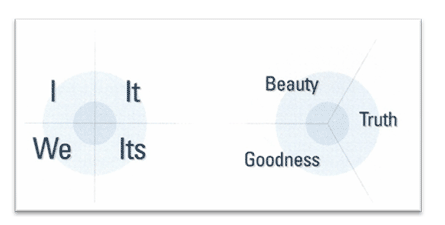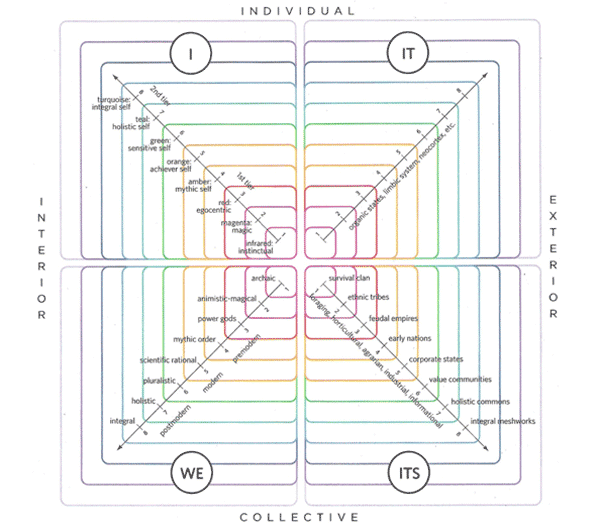All Quadrants All Lines – Ken Wilber
The quadrants represent the innate perspectives found in all individual sentient holons (whole/parts), and extend “all the way up and down,”-from physical (atoms) to biological (cells) to psychological (minds) to psychic (souls) to spiritual (causal) holons. As Wilber assimilated the “linguistic turn” of postmodern philosophy, he realized that the quadrants occurred in all modern languages as first- (“I”), second- (“You/We”), and third-person (“It/Its”) perspectives. These horizontal dimensions-perspectives help situate a dizzying array of concepts within what Wilber sometimes simplifies as “the big three.” For example: Max Weber’s three value spheres of art (“I”), morals (“We”), and science (“It”); Plato’s the beautiful (“I”), the good (“We”), and the true (“It”); Karl Popper’s three worlds: subjective (“I”), cultural (“We”), and objective (“It”); Jürgen Habermas’ three validity claims: subjective sincerity (“I”), intersubjective justness (“We”), and objective truth (“It”); Immanuel Kant’s Critique of Judgment (“I”/aesthetics), Critique of Practical Reason (“We”/morals), and Critique of Pure Reason (“It”/objective science), and so on.
According to Wilber:
Thus, an integrally informed path will take all of those dimensions into account, and thus arrive at a more comprehensive and effective approach-in the ‘I’ and the ‘we’ and the ‘it’-or in self and culture and nature.
If you leave out science [Upper- and Lower-Right], or leave out art [Upper-Left], or leave out morals [Lower-Left], something is going to be missing, something will get broken. Self and culture and nature are liberated together or not at all. So fundamental are these dimensions of ‘I,’ ‘we,’ and ‘it that we call them the four quadrants, and we make them a foundation of the integral framework…. (We arrive at ‘4′ quadrants by subdividing ‘it’ into singular ‘it’ and plural ‘its.’

Wilber realized that while the Upper-Left quadrant anchors individual interiority (the emphasis of Spectrum-1 through Spectrum-3), consciousness must be more broadly defined as a tetra-mesh of all four quadrants. All development and evolution has these four innate perspectives, and therefore we find tetra-development and tetra-evolution within individual holons. So the quadrants organize the bare minimum framework to properly situate the other five core organizing principles that permeate every holon-every whole/part relationship in the manifest world: levels, lines, states, types, and self-system. According to Wilber:
The first step toward a genuine theory of consciousness is the realization that consciousness is not located in the organism. Rather, consciousness is a four-quadrant affair, and it exists, if it exists at all, distributed across all four quadrants, anchored equally in each.
… In short, if you take away any of those quadrants-intentional, behavioral, cultural, or social-you will destroy any manifest consciousness. And that means, very simply, that consciousness is located solely in none of those domains. Consciousness is not located merely in the physical brain, nor in the physical organism, nor in the ecological system, nor in the cultural context, nor does it emerge from any of those domains. Rather, it is anchored in, and distributed across, all of those domains with all of the available levels.
Source: KEN WILBER’S AQAL METATHEORY – An Overview – by PAUL M. HELFRICH, PH.D